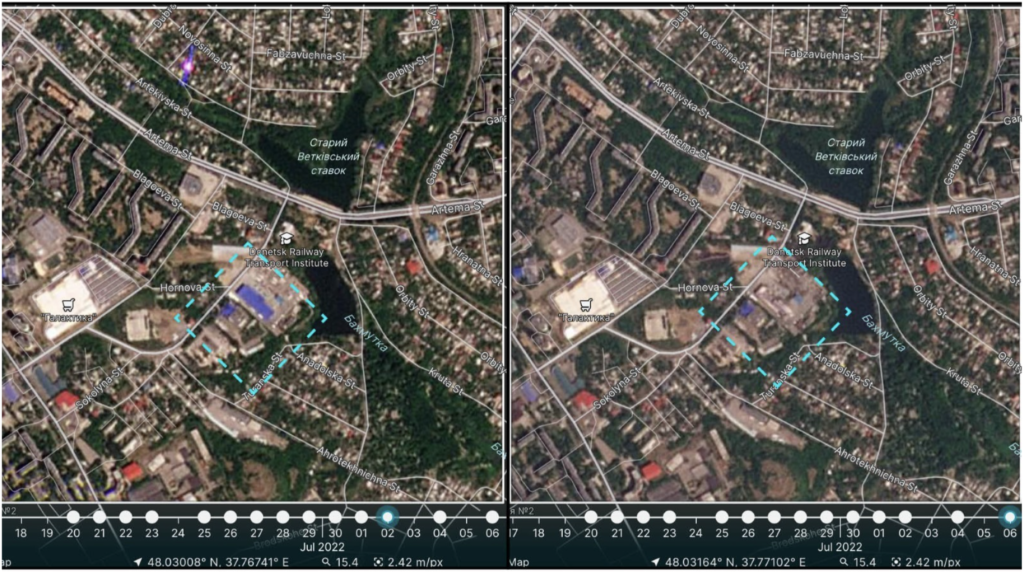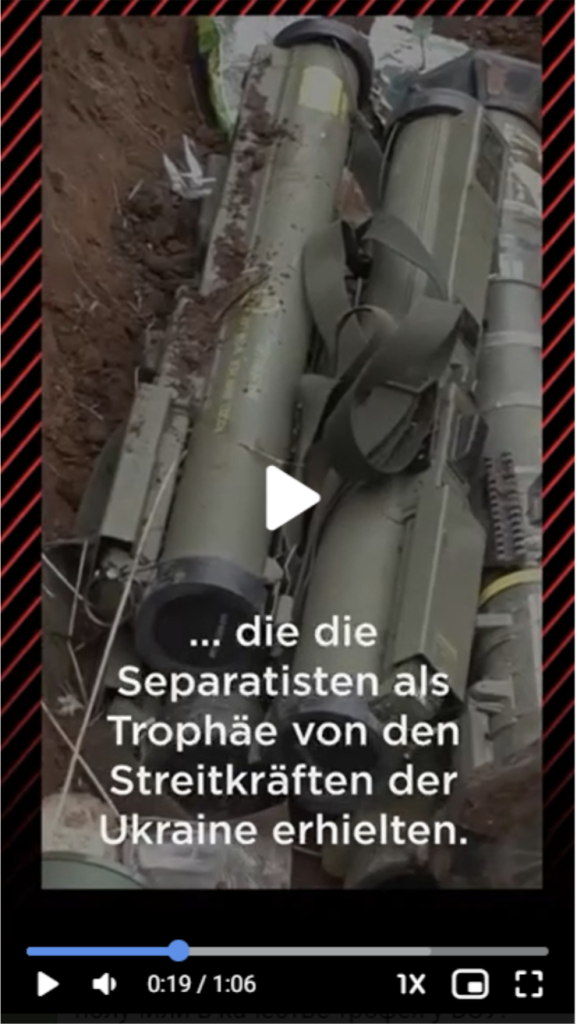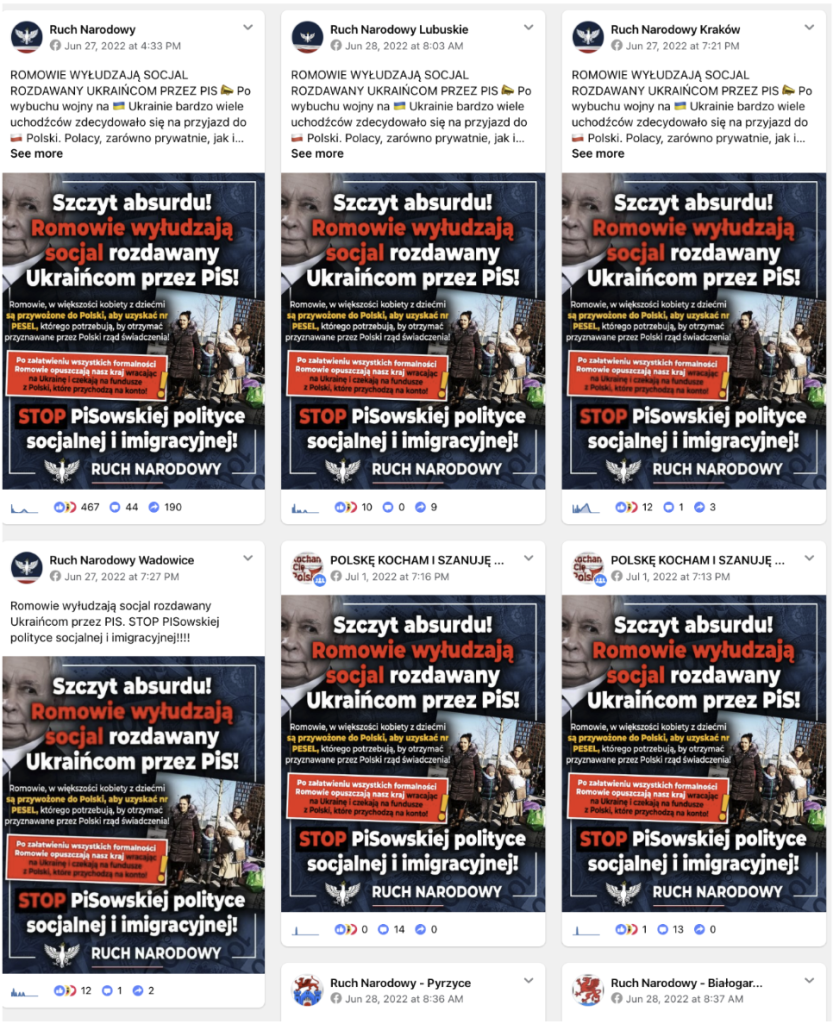As Russia continues its assault on Ukraine, the Atlantic Council’s Digital Forensic Research Lab (DFRLab) is keeping a close eye on Russia’s movements across the military, cyber, and information domains. With more than seven years of experience monitoring the situation in Ukraine—as well as Russia’s use of propaganda and disinformation to undermine the United States, NATO, and the European Union—the DFRLab’s global team presents the latest installment of the Russian War Report.
Security
Ukraine uses HIMARS effectively to hit Russian ammo dumps
Tracking Narratives
Kremlin outlets amplify footage of Lysychansk residents greeting Russian troops
Kremlin media “predicts” disintegration of NATO and EU despite plans of expansion
Polish right-wing political party launches campaign targeting Roma people from Ukraine
Pro-Kremlin Telegram channel linked to inauthentic Facebook assets from Côte d’Ivoire
Ukraine uses HIMARS effectively to hit Russian ammo dumps
At the beginning of the month, the Biden administration announced it was sending a small batch of M142 HIMARS multiple rocket launchers. This decision was long awaited on the Ukrainian side, which lacked precision artillery systems that are able to hit Russian targets deep behind the frontlines. The first videos of HIMARS on the battle front appeared online as early as July 4.
Despite the limited numbers of HIMARS currently available to Ukraine, the impact on the field can already be felt. At the moment, Ukraine operates nine HIMARS; upon receiving the systems, Ukrainian military started systematically targeting Russian ammunition storage facilities behind the frontlines.
During the past week, a number of ammunition dumps were reported to be on fire all over the occupied Ukrainian territory. On July 4, Ukrainian diplomat Olexander Scherba claimed the system was already making an impact. Three days later, videos of a bombardment of the Donetsk Kamaz truck center started appearing online. Allegedly, this was the location where Russian troops were keeping their ammunition supplies in Donetsk.
DFRLab analysis of recent satellite imagery concludes that the Kamaz truck center was indeed damaged between July 2 and July 4. Due to a lack of visible damage among surrounding buildings, this was likely a precision weapon attack, such as newly acquired HIMARS.

Equipment that was believed to have been used in parades organized by the so-called Donetsk People’s Republic was also destroyed, according to the recently surfaced photos. Another hit on an alleged ammunition storage facility in Donetsk was reported on July 5 and July 7; at the time of publishing, satellite imagery to verify these claims is unavailable.
Additional reports of targeted Russian ammunition dumps include July 2 in Popasna, July 4 in Snizhne and Yakovlivka, July 5 in Kadiivka, July 6 in Makiivka, as well as other locations.
—Lukas Andriukaitis, DFRLab Associate Director, Brussels, Belgium
Kremlin outlets amplify footage of Lysychansk residents greeting Russian troops
Kremlin propaganda media outlets and social media accounts published numerous videos showing residents of Lysychansk greeting Russian armed forces upon upon entry into the city on July 3. The official Telegram and VK accounts of Ramzan Kadyrov, the leader of Chechen Republic, published videos with people hugging Kadyrov’s soldiers and thanking them for humanitarian aid and “liberating” them. Yuri Podolyaka, a pro-Kremlin Ukrainian blogger, amplified videos by both Kremlin-controlled media outlets like RIA Novosti, and independent western media outlets like France 24 showing some residents of Lysychansk happy with Russian troops entering the city and condemning Ukrainian troops. Other VK accounts that used pro-Kremlin letter Z as their avatar image or in their name also posted videos with elderly women from Lysychansk blessing Russian military and hugging them after coming up from a basement. Another popular video posted by the Operativnye Svodki Telegram channel showed a girl showing her pro-Kremlin drawings of Russia’s flag and the letters ZOV saying “she knew that [Russian troops] will come.”
While the footage is legitimate, the sentiment can be found among the small fraction of Lysychansk residents who chose to stay behind and not evacuate the city. There were 93,340 residents in Lysychansk as of January 1, 2022, according to the Ukrainian Ministry of Economics. On June 29, Unian.net, a Ukrainian news agency, cited Sergey Gaidai, chairman of the Luhansk Regional Military Administration, saying that 15,000 still people remained in the city. On July 5, BBC Russian service reported that only 10,000 people remained in now-occupied Lysychansk; he same number of Lysychansk residents was mentioned by the Kremlin-controlled MK.ru on July 2.
—Nika Aleksejeva, Lead Researcher, Riga, Latvia
Pro-Kremlin Telegram channels amplify fake Bild video claiming self-propelled German howitzer captured
Multiple pro-Kremlin media claimed that Russians knocked out a Germany-provided PzH 2000 self-propelled howitzer and captured it for further study. All the articles referenced German media Bild as the source, but failed to provide a direct link to the material. The story was debunked by the Ukrainian fact-checking organization StopFake after it determined that Bild had not reported anything on the claim and had only published material on how Ukrainians started using those systems. StopFake also cited a German journalist who tried to find any confirmation but concluded it was Russian disinformation. To date, no evidence of a captured PzH 2000 has been provided by any verifiable source.
However, pro-Kremlin Telegram channel MediaKiller published a short clip with German subtitles claiming that a Bild video confirmed the system’s capture. While the footage mixes random clips of various military munitions with German subtitles on top of it, it does not provide any evidence of a PzH 2000 being captured. The DFRLab searched for videos published by Bild and could not find anything corresponding to Russia’s claims. Furthermore, the video amplified on Telegram does not follow Bild’s visual style and is far shorter than Bild’s usual social media videos. Finally, the text on the video contains mistakes, like the usage of the German definitive article ‘die’ twice in a row, which is a highly unlikely mistake for German news outlet.
The video was amplified by multiple pro–Kremlin channels, some of which claimed that it signals that the West is tired of “pointless” support of Ukraine. One of those channels is a personal channel of Alexey Pushkov, a former Russian senator of the Perm region.

It is not the first time MediaKiller has published faked video posing as reputable media. Previously, the channel promoted a fabricated BBC video that blamed Ukraine for shelling the Kramatorsk train station.
—Roman Osadchuk, Research Associate
Kremlin media “predicts” disintegration of NATO and EU despite plans of expansion
Kremlin-owned media outlets attempt to sow division among NATO and EU member countries by claiming that some members are willing to leave the alliances, and that the organizations are planning to remove them. These narratives come after both organizations have initiated plans to expand: NATO allies have signed accession protocols for Sweden and Finland, while the EU has granted candidate status to Ukraine and Moldova and recognized Georgia’s “European Perspective.”
The Kremlin media outlets reported that in Turkey, the Vatan political party has launched a campaign to leave NATO. The outlets cited the Turkish newspaper Aydınlık, a well-known pro-Russian platform in the country. Vatan is a fringe pro-Russian party that has been calling on the Turkish government to recognize Crimea as Russian territory.
According to Kremlin media, Vatan launched a large-scale campaign in major cities of Turkey on withdrawing the country from NATO. The articles claimed that an anti-NATO stance is important for the economic future of Turkey, and added that “citizens are actively signing the appeal.” In 2017, the DFRLab investigated how the Vatan party, bots, and Kremlin media were promoting #LetsLeaveNATO hashtag on Twitter that was trending on Turkish Twitter at the time. While Lenta.ru published the same article on the possibility of Turkish exit, the outlet also published a separate article claiming that NATO itself wants to force Turkey out the alliance. According to the second piece, NATO would want to remove the country because of Ankara’s “overly independent and categorical policy” and because “Turkey can destroy NATO from within.”
Russian websites predicted the disintegration of European Union along with NATO. Additional Kremlin-owned outlets also claimed that France might leave the European Union soon. According to the outlets, President Emmanuel Marcon’s “failure in parliamentary elections” increases the chances of holding the referendum in France on leaving the EU.
—Eto Buziashvili, Research Associate, Washington DC
Polish right-wing political party launches campaign targeting Roma people from Ukraine
On June 24, Przemyśl city councilmember Marcin Kowalski posted on his Facebook page that “hordes of Ukrainian Roma” had started to arrive in the city, allegedly brought to Poland on purpose in order to obtain a Polish identification number and receive financial aid from Poland as Ukrainian refugees. His post asserted that most of the Roma coming to Poland were women with small children; after filling out formal documents in Poland, he said, they planned to return to Ukraine and wait there to receive Polish state aid in their Polish bank accounts. In his post, Kowalski asked the Polish government whether they considered the potential for fraud while adopting a law for providing assistance to Ukrainian refugees in March, 2022. He alleged that he had been helping Ukrainian people ever since the war erupted, but he cannot indifferently watch how people used loopholes in this law.
Kowalski’s post was featured in articles published by far-right and regional local online media outlets, including Kresy.pl, wkraju24.pl, Dzieje się na Podkarpaciu, Ziemia-Przemyska and Lega Artis law firm. Posts about “hordes of Roma people from Ukraine” was shared in thirty Facebook groups and pages on June 24 and 25, garnering more than 900 interactions.
On June 27, the far-right National Movement party which currently has five members in Poland’s parliament, launched a campaign on Facebook claiming that Roma people were extorting social benefits intended for Ukrainian refugees. According to the campaign, “The government’s refugee aid policy turned into an immigration policy,” and its incompetence has allowed unentitled people to receive aid. The Facebook posts also contained banners with text repeating messages from Marcin Kowalski’s original Facebook post and asserted that Poland’s current immigration policy must be stopped. The DFRLab found that banner was posted on forty Facebook pages and public groups, garnering 880 interactions between June 27 and July 7.

On June 30, Marcin Kowalski posted on Facebook that his previous post about Roma people reached almost 100,000 users, and that he had received messages and calls from many sources, including reporters from TVN TV. But he wrote with disappointment that Polish lawmakers did not pay enough attention to this story and only Paweł Szramka, member of Polish parliament from the Polish People’s Party, had taken it into consideration. Kowalski published a screenshot of a request sent by Paweł Szramka to the Polish Ministry of Family and Social Policy. The request quoted Kowalski’s Facebook post and asked whether the ministry intended to tighten existing legislation in order to curb misuse of state refugee benefits.
Despite his claims, Kowalski’s post does not provide any evidence that Roma people are returning to Ukraine after registering for Polish government aid. A spokesperson for Poland’s social insurance agency ZUS stated that ZUS verifies the legal stay of Ukrainian citizens in Poland, both at the stage of granting benefits and during the period when they receive social aid. Moreover, ZUS has access to various state registers, including a special register of Ukrainian citizens made by the Border Guard, to verify the status of refugees. If people from Ukraine with refugee status leave Poland for longer than one month, they lose benefits offered by Polish state. Thus it is unlikely that anyone, Roma or otherwise, would continue to receive aid from Poland if they returned to Ukraine. The Central Council of Roma People in Poland wrote on Facebook that Kowalski’s post nurtures stereotypes against Roma and the organization would take legal steps in response to his post.
—Givi Gigitashvili, DFRLab Research Associate, Warsaw, Poland.
Pro-Kremlin Telegram channel linked to inauthentic Facebook assets from Côte d’Ivoire
A new investigation by the DFRLab has determined that a Facebook user in Abidjan, Côte d’Ivoire created a network of sockpuppets and duplicate profiles used to operate Facebook pages and at least one private group with over 62,000 followers to spread anti-Ukraine content and promote pro-Kremlin narratives in French.
One inauthentic profile was called “Igor Kadyrov” and used a picture of Chechen General Magomed Tushayev as its profile picture. Another shared content from Sputnik and encourage followers to subscribe to RT France.
Notably the Facebook assets were also used to promote a Telegram channel entitled “Marigo News – Opération ZOV.” The channel, which has gained over 11,600 followers in less than three months, appeared to be copying content directly from another channel called “Операция Z: Военкоры Русской Весны” (“Operation Z: War Reporters of the Russian Spring”) and auto-translating it from Russian into French. Although it is not the official channel of the pro-Kremlin propaganda website RusVesna, “Operation Z” contains links to RusVesna in the channel description, and the official RusVesna Telegram channel frequently shares content from it.
The French version of RusVesna content was spread across Facebook and to Twitter accounts that have subsequently been suspended.
—Tessa Knight, Research Associate, Cape Town, South Africa
Image: The Ukrainian Armed Forces on July 5, 2022 shows the soldiers set up U.S supplied High Mobility Artillery Rocket Systems, or HIMARS multiple rocket launcher systems with a 43-mile range in Ukraine. On June 23, the U.S announced it was supplying four HIMARS to Ukraine. These systems, which will join the four already sent to the country, are part of an ongoing effort to bolster its military in its fight against the Russian invasion. While towed artillery can be set up, fired, and then driven away from where it fired, self-propelled artillery like the HIMARS lets the vehicle drive away immediately after firing, taking full advantage of its range and mobility to attack enemies and escape retaliation.
